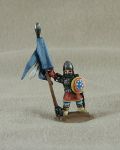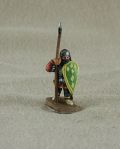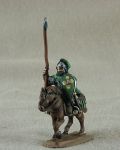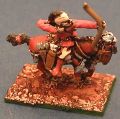Komnenan Byzantine
| Navigation - HomePage - The Rise of Rome - Storm of Arrows - Immortal Fire - Legions Triumphant - Swords and Scimitars - Eternal Empire - Decline and Fall - Wolves from The Sea - Swifter Than Eagles |
Historical Overview Section
1071-1204
The Seljuk Turks made their first forays into Byzantine Armenia in 1065 and in 1067. The emergency lent weight to the military aristocracy in Anatolia who, in 1068, secured the election of one of their own, Romanos Diogenes, as emperor. In the summer of 1071, Romanos undertook a massive eastern campaign to draw the Seljuks into a general engagement with the Byzantine army but at Manzikert Romanos not only suffered a surprise defeat at the hands of Sultan Alp Arslan, but was also captured. Alp Arslan treated him with respect, and imposed no harsh terms on the Byzantines. But his friends were not so gracious - in Constantinople a coup took place in favor of Michael Doukas, ushering in the Komnenan period.
After Manzikert, a partial recovery (referred to as the Komnenian restoration) was made possible by the efforts of the Komnenian dynasty. The first emperor of this dynasty was Isaac I (1057–1059) and the second Alexios I. At the very outset of his reign, Alexios faced a formidable attack by the Normans under Robert Guiscard and his son Bohemund of Taranto, who captured Dyrrhachium and Corfu, and laid siege to Larissa in Thessaly. Robert Guiscard's death in 1085 temporarily eased the Norman problem. The following year the Seljuq sultan died, and the sultanate was split by internal rivalries. By his own efforts, Alexios defeated the Pechenegs; they were caught by surprise and annihilated at the Battle of Levounion on 28 April 1091. He still however did not have enough manpower to recover the lost territories in Asia Minor and to advance against the Seljuks, and in what turned out to be a bit of a daft move, appealled to the Pope for Western aid. THis led to a huge undisciplined army of Early Crusaders roaming around Byzantine and Middle Eastern territory for several years, capturing part of the Holy Land and also - on occasion- going to war with Byzantium.
Alexios' son John II Komnenos succeeded him in 1118, and was to rule until 1143. In the course of his twenty-five year reign, John made alliances with the Holy Roman Empire in the west, decisively defeated the Pechenegs at the Battle of Beroia and personally led numerous campaigns against the Turks in Asia Minor. John's campaigns fundamentally changed the balance of power in the east, forcing the Turks onto the defensive. In the later part of his reign John focused his activities on the East. He defeated the Danishmend emirate of Melitene, and reconquered all of Cilician Armenian territory, while forcing Raymond of Poitiers, Prince of Antioch, to recognize Byzantine suzerainty.
John's chosen heir was his fourth son, Manuel I Komnenos, who campaigned aggressively against his neighbours both in the west and in the east. In Palestine, he allied himself with the Crusader Kingdom of Jerusalem and sent a large fleet to participate in a combined invasion of Fatimid Egyptian lands. Manuel reinforced his position as overlord of the Later Crusader states, and sent an expedition to Italy in 1155, but disputes within the coalition led to the eventual failure of the campaign. Despite this military setback, Manuel's armies successfully invaded the Kingdom of Hungary in 1167, defeating the Early Hungarians at the Battle of Sirmium. By 1168 nearly the whole of the eastern Adriatic coast lay in Manuel's hands., He also made several alliances with the Pope and Western Christian kingdoms, and successfully handled the passage of the Second Crusade through his empire.
In the east, however, Manuel suffered a major defeat at the Battle of Myriokephalon, in 1176, against the Turks, although the losses were quickly made good, and in the following year Manuel's forces inflicted a defeat upon a force of "picked Turks". The Byzantine commander John Vatatzes, who destroyed the Turkish invaders at the Battle of Hyelion and Leimocheir not only brought troops from the capital but also was able to gather an (allied) army along the way; a sign that the Byzantine army remained strong and that the defensive program of western Asia Minor was still successful.
Manuel's death on 24 September 1180 left his 11-year-old son Alexios II Komnenos on the throne - an unpopular monarch who ws a virtual puppet of his mother and her faction. Eventually Andronikos I Komnenos, a grandson of Alexios I, launched a revolt against his younger relative and managed to overthrow him in a violent coup d'état. Despite his military background, Andronikos failed to deal with Béla III who reincorporated Croatian territories into Hungary, and Stephen Nemanja of Serbia who declared his independence from Byzantium. Yet none of these troubles would compare to William II of Sicily's invasion force of 300 ships and 80,000 men, arriving in 1185. He was finally overthrown when Isaac Angelos, surviving an imperial assassination attempt, seized power with the aid of the people and had Andronikos killed. The reign of Isaac II, and, still more, that of his brother Alexios III, saw the collapse of what remained of the centralized machinery of Byzantine government and defense. Although, the Normans were driven out of Greece, in 1186 the Vlachs and Early Bulgarians began a rebellion that was to lead to the formation of the Second Bulgarian Empire.
The end came with the 4th Crusade - an ill-starred affair which had already seen the virtual sack of Venice and things were not going to go well when this mod arrived at Byzantium. The crusaders arrived at the city in the summer of 1203, and Alexios III fled from the capital. The crusaders took the city on 13 April 1204. Constantinople was subjected by the rank and file to pillage and massacre for three days. When order had been restored, the crusaders and the Venetians parcelled out the assets of the city and empre - Baldwin of Flanders was elected emperor and the Venetian Thomas Morosini chosen patriarch. The lands parcelled out among the leaders did not include all the former Byzantine possessions, however Byzantine rule continued only in Nicaea, Trebizond, and Epirus
The Byzantine Armies in order
- Early Byzantine : 493 - 550 The Eastern Roman Empire & Belisarius on the offensive - Mixed & Bw/Sw Cv units and "legionaries" - D&F
- Maurikian Byzantine : 550 - 650 Loss of Africa, The Strategikon, War with Persia & The Arabs - Good quality Ln & Bw/Sw Cv, Mixed Skoutatoi but no LH - D&F
- Thematic Byzantine : 650 - 963 The Thematic System, Tagmatic units fighting the Caliphates - Mixed units & Bw/Sw Cv, Average & Poor units, Cataphracts - D&F
- Nikephorian Byzantine : 963 - 1071 Basil bashes the Bulgars, Normans conquer Italy, Manzikert loss to the Turks - Bw* or Ln Cavalry, Varangians, lots of mixed spearmen & some Normans - D&F
- Komnenan Byzantine : 1071 - 1204 Manzikert to Fall of Constantinople to the Crusaders - Lancer Cv, some KN, Varangians - S&S
- Post Latin Conquest Byzantine : 1204 - 1261 Nikaia, Epiros, Trebizond vs the Latin Kingdoms - Frankish Kn, lots of archers, - S&S
- Late Byzantine : 1261 - 1461 Byzantium, Epirus, Morea & Trebizond until their fall to the Turks - Cv Lancers, 4 Kn, lots of archers - EE
Using the army in FoG
- The Army breaks into two periods, the earlier period before 1143 when Byzantine cavalry are supported by irregular horse archers and Latin knights and the period post, 1143 when byzantine cavalry have retrained as knights but there are few of them. the earlier option provides a more balanced force, whilst the later combination is a powerful mixture of knights and regular horse archers. Except for the Varangian Guard infantry are mediocre.
- The latter period army is extremely dangerous in neutral or favourable terrain, with mounted firepower and highly disciplined mercenary regular shock knights.
- They are best used as combined armies - maxing out on a single troop stype/category will miss the strengths of the army. But combined arms takes practice to get right!
- There is a cheap BG in the list of 4 LF Undrilled Poor Javelins for 8 points.
- 3 BGs of Latinikon may be too many. Consider 2 BG and use the points saved to fortify the camp (benefits a small army) and add another BG (maybe another 6-pack of LF archers).
- With no MF options, maybe best to ignore it and fight in th eopen - very effectively!
- The unfortunate thing about this list is that the later period, in particular, bears limited resemblance to the Byzantine army of Manuel I as described in the sources, which was much more substantially a native Byzantine army, with a backbone of regular cavalry, supported by mercenaries; thus this is an army for the competition player , not the historian, but that aside the combination of pinning horse archers and highly disciplined shock choosing its time and place to attack is extremely dangerous
- A valid Byzantine tactic is to open the game by offering your opponent cash to concede the battle without fighting, with an additional future payment should they agree to add their forces to yours for future engagements against unspecified third parties. Alternatively suggesting they concede in exchange for the hand of your cousins daughter in marriage, a generous annual pension and a nice estate in Anatolia can sometimes also pay dividends.
Necessary changes to the list
An extensive debate has happened on the DBMM site using the sources and here are the major changes in summary that would need to happen to the FOG list to correct the historical errors:
Early Period
- a proportion of cavalry continue to operate as cursores at least until the reign of John II - thus better cavalry are Bow*lance or can detach cursores - cavalry, protected bow and sword.
- Turkopoles are doubtful or may just be irregular Turkish mercenaries,
- significant numbers of skythikon don't appear until the defeat of the Partinaks in 1092 and the wholesale incorporation of POWs into the army
- Manicheans may just be rebellious Byzantine military settlors with heretical beliefs - the debate goes on
- The Varangians disappear as a field unit between being wiped out in 1081 and the some point between 1110 and 1122
Late period
- Many more native armoured knights; there is no evidence that the number of native troops fell which the FOG list erroneously states. The battle reports in the sources describe native Byzantine cavalry as the dominant part of the cavalry in action and by description of army composition on most occassions
- Fewer Latinikon, though enough that they can still be the dominant part of the cavalry as sometimes happened
Throughout
- More tributary nation contingents in the list as Byzantine policy often involved forcing defeated enemies to contribute troops to the Emperor's armies; this would require options for small units, say 4 bases of Serb knights and / or spearmen, Turkish Ghulams and possibly Hungarian knights or horse archers.
- the option to recruit from the hillt tribes of the Balkans, thus medium infantry spearmen and light foot
- Some Byzantine cavalry through recruitment as elite units eg the Vestariate or "Troops Around the Emperor"or through successful long term campaigning eg later in the reign of John II deserve the option to upgrade to superior
UK Tournament Results with this army
1 / 12 Komnenan Byzantine Chester Doubles 2008 (S&S)
13 / 62 Komnenan Byzantine Britcon 2008 15mm (open)
52 / 62 Komnenan Byzantine Britcon 2008 15mm (open)
53 / 62 Komnenan Byzantine Britcon 2008 15mm (open)
19 / 20 Konmenan Byzantine Warfare 2008 15mm (S&S, SoA, EE)
Useful Links
User-contributed links about this army:
- Komnenan Byzantine (Richard Gorringe) DBA Figure Gallery for this army - from Fanaticus
- Register and you can put you own link in here and then write some brief detail about the link here
- put the link text readers will see in here write some more detail about the link here
Allies
- Crusader, Later : Dates: From 1150 Swords and Scimitars page 9 : Proper knights from 1150 onwards armoured spearmen and some MF Crossbows - not to be sniffed at
- Turk, Seljuk : Dates: Any Swords and Scimitars page 18 : Bw/Sw Superior Armoured Cavalry, and Bw/Sw LH or Protected Cavalry to support - fairly standard Arab ally
- Cuman : Dates: Before 1150 Swords and Scimitars page 21 : Can be fielded just as lots of Bw/Sw LH, with optional Armoured Cv to stiffen it
- Armenian, Cilician : Dates: From 1150 Swords and Scimitars page 27 : Hvy Knight lancers with 2 units of take-it-or-leave it infantry to boost break points
15mm Manufacturers supplying figures for this army
You can see some of the figures in the Ancients Photo Gallery also on this site
Many manufacturers produce just one "Byzantine" range, not specifying which era they are for (but most are Maurkikian era I suspect). All generic "Byzantine" ranges have been listed here, together with any specifically noted for particular eras. For Latin or other allied troops, use Crusader or other knights of a similar timeframe. 700AD - in the Thematic list - is as good a date as any for round shields to start to change over to kite shields.

|

|

|
|

|
- Essex Miniatures - Several Byzantine ranges. 8 Maurikians, 7 Thematics, 10 Nikephorians & 5 Generic Psiloi for all era in their Ancients ranges.
- Donnington 22 Byzantines, including a Belisarius general figure (a clue to them being fairly early maybe..) plus a 23-strong C12-13 range
- Museum Miniatures - 17 Byzantines, reasonably early period.
- Gladiator Miniatures by Fighting 15's (Previously Black Hat) - 10 Komnenans in their Crusades range
- Old Glory 15's - 12 Belisarians, and 22 codes in a "7th-13th Century Byzantine" range
- Minifigs - 21 Byzantines, from C7-C11 in their Dark Ages range, 5 more C11-13 ones in their Crusades range
- Irregular Miniatures - 21 Byzantines, with Nikephorian, Tagmatic, Thematic, Maurikian and Belisarian cavalry listed as well as CC7-10 oval-shield foot and C11-13 kite-shielded foot
- Tin Soldier 21 10th & 11th Century Byzantines
- Battle Line Miniatures (NZ) Same range as Isarus
- Alain Touller - almost 20 Byzantines with both kite and round shields
- Isarus - sold by 15mm.co.uk 18 Byzantines, kite-shielded lancers and round-shielded bowmen
- Outpost Wargame Services 10 Crusade-era Byzantines
- Khurasan Miniatures - 20-odd Nikephorian Byzantines (kite shield infantry)
- Viking Forge - Generic range of 20 or so Byzantines, Tagmatic and Thematic cavalry are listed
- 50 Paces/Miniature Wars - 10 -strong Belisarian (early) range
Core Troops
Which troops are absolutely needed for this army, and what are your thoughts on how to organise, paint and buy them.
Army Lists
Sample army lists for this army
- 1 Javelinmen A LF Unprotected Poor Drilled Javelins Light spear - - 4 2 8
- 2 Byz Archers A LF Unprotected Average Drilled Bow - - - 6 5 30
- 3 Skythikon A LH Unprotected Average Undrilled Bow - Swordmen - 4 10 40
- 4 Skythikon B LH Unprotected Average Undrilled Bow - Swordmen - 4 10 40
- 5 Kavallaroi B Kn Armoured Average Drilled - Lancers Swordmen - 4 18 72
- 6 Byz Archers B LF Unprotected Average Drilled Bow - - - 6 5 30
- 7 Kavallaroi C Kn Armoured Average Drilled - Lancers Swordmen - 4 18 72
- 8 Latinkon C Kn Heavily armoured Superior Drilled - Lancers Swordmen - 4 26 104
- 9 Latinkon C Kn Heavily armoured Superior Drilled - Lancers Swordmen - 4 26 104
- 10 Varangians D HF Heavily armoured Elite Drilled - - Heavy weapon - 4 17 68
- 11 Varangians D HF Heavily armoured Elite Drilled - - Heavy weapon - 4 17 68
- Troop Commander TC - - - - - - - 4 35 140
- Fortified Camp CAMP - - - - - - - 1 24 24
A version with plenty of frontal clout!
Aren't Heavily Armoured Elite Varangians 19 pts each?
800 AP
- 4 TC
- 2 Latinikon 4 x Kn/Dr/Sup/Hvy Arm/Ln/Sw
- 2 Kavallaroi 4 x Kn/Dr/Av/Arm/Ln/Sw
- 2 Skythikon 4 x LH/UnDr/Av/UnProt/Bw/Sw
- 2 Varangian 4 x HF/Dr/Elite/HvyArm/HW
- 2 Archers 6 x LF/Dr/Av/UnProt/Bw
- 1 Javelins 4 x LF/Dr/Pr/Unprot/JLS
- Fortified Camp
11 BGs 800 points.
In hindsight, drop one BG of the Kavallaroi to add some LF Archers and/or change to an IC + 2 TC command structure. The army is still pretty small, but it hits hard.
794 AP list
- c-in-c IC 80
- sub Troop Sub 1 35
- Allied tc 25
- Byzantine Cavalry kn Armoured average drilled - Lancer Swordsmen - 4 18 72
- Latinikon kn Heavily Armoured superior drilled - Lancer Swordsmen - 4 26 104
- Latinikon kn Heavily Armoured superior drilled - Lancer Swordsmen - 4 26 104
- Ghilman cv armoured superior drilled bow sword - 4 76
- Ghilman cv armoured superior drilled bow sword - 4 76
- seljuk lh unprotected average undrilled bow Swordsmen - 4 10 40
- skytikon lh unprotected average undrilled bow Swordsmen - 4 10 40
- skytikon lh unprotected average undrilled bow Swordsmen - 4 10 40
- skytikon lh unprotected average undrilled bow Swordsmen - 4 10 40
- byz arch lf unprotected poor drilled bow - - 6 3 18
- byz arch lf unprotected poor drilled bow - - 6 3 18
- byz arch lf unprotected poor drilled bow - - 6 3 18
- byz jav lf unprotected poor drilled Javelins Light Spear - 4 4 8
798 AP
- c-in-c Troop CinC 1 35
- sub Troop Sub 1 35
- sub Troop Sub 1 35
- sub Troop Sub 1 35
- Byzantine Cavalry kn Armoured average drilled - Lancer Swordsmen - 4 18 72
- Latinikon kn Heavily Armoured superior drilled - Lancer Swordsmen - 4 26 104
- Latinikon kn Heavily Armoured superior drilled - Lancer Swordsmen - 4 26 104
- Latinikon kn Heavily Armoured superior drilled - Lancer Swordsmen - 4 26 104
- skytikon cv protected average undrilled bow Swordsmen - 4 11 44
- skytikon lh unprotected average undrilled bow Swordsmen - 4 10 40
- skytikon lh unprotected average undrilled bow Swordsmen - 4 10 40
- skytikon lh unprotected average undrilled bow Swordsmen - 4 10 40
- skytikon lh unprotected average undrilled bow Swordsmen - 4 10 40
- byz arch lf unprotected poor drilled bow - - 6 3 18
- byz arch lf unprotected poor drilled bow - - 6 3 18
- byz arch lf unprotected poor drilled bow - - 6 3 18
- byz jav lf unprotected average drilled Javelins Light Spear - 4 4 16
2010 Burton Doubles 895 AP (circa 1100AD)
- c-in-c IC CinC 1 80
- sub TC Sub 1 35
- sub TC Sub 1 35
- sub TC Sub 1 35
- Byzantine Cavalry cv Armoured average drilled - Lancer Swordsmen - 4 13 52
- Byzantine Cavalry cv Armoured average drilled - Lancer Swordsmen - 4 13 52
- Latinikon kn Armoured superior drilled - Lancer Swordsmen - 4 26 104
- Latinikon kn Armoured superior drilled - Lancer Swordsmen - 4 26 104
- Latinikon kn Armoured superior drilled - Lancer Swordsmen - 4 26 104
- Skythikon lh unprotected average undrilled bow Swordsmen - 4 10 40
- Skythikon lh unprotected average undrilled bow Swordsmen - 4 10 40
- Skythikon lh unprotected average undrilled bow Swordsmen - 4 10 40
- Skythikon lh unprotected average undrilled bow Swordsmen - 4 10 40
- byz arch lf unprotected poor drilled bow - - 6 3 18
- byz arch lf unprotected poor drilled bow - - 6 3 18
- byz spears hf protected average drilled - Defensive Spear - 6 7 42
- Varangians hf armoured superior drilled - Heavy Weapon - 4 13 52
- Varangians hf armoured superior drilled - Heavy Weapon - 4 13 52
The army was better than the general, and on the one occasion that the Latinikon knights got properly stuck it was rewarded with success. The shooty Skythikons generally did well, right up to the point they ran out of room and evaded through the waiting knights, spreading doubt and confusion.
No blame attaches to my partner, who was unable to make it to Burton.
eBay Listings
UK Bookstore